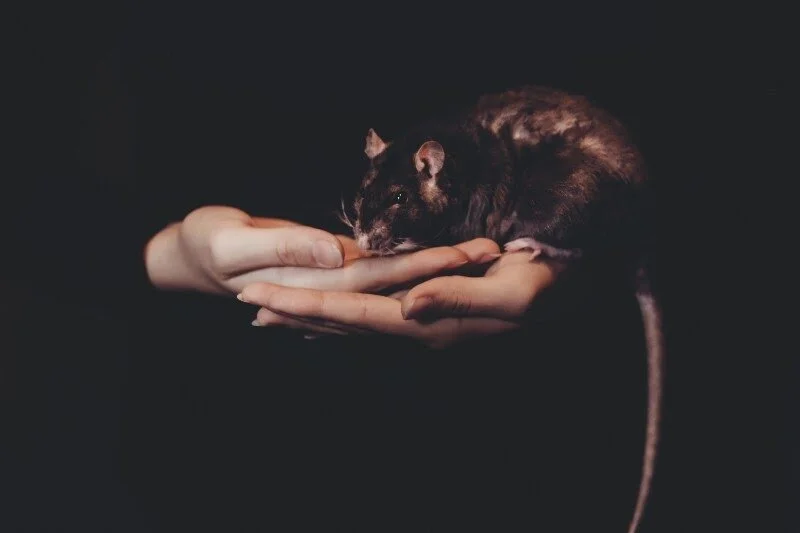You Don’t Name the Mice
“Everyone has heard of the dog suffering under vivisection who licked the hand of the operator; this man, unless he had a heart of stone, must have felt remorse to the last hour of his life.”
— -Charles Darwin
He stood still as he faced his fate. The hand that picked him up was monstrous. As the familiar feeling of the bedding under his paws and the smell of the cage left him, his tiny heart began to beat faster and faster. To his exquisite ears, the sound of his anguished heart must have been like a jack hammer.
Jess started to sing with a painfully tender voice, the kind of voice a mother uses when addressing her newborn child:
“Heeeyyy mousy mousy, heeeeyyy mousy mousy.”
“Is it weird that I sing to them before…?” Jess asked, without looking at me.
“No.” I lied.
The creature, which did not have a name, had fur as white as fresh snow and smelled like wet hay. His eyes were the color of blood.
“Twenty’s a good sample size.”
Dr. R. rubbed his scruffy chin and examined my proposal carefully. He looked like he had been drawn purely out of straight lines, tall and lean, with the build of a long-distance runner.
I sat in his office,patiently waiting for his verdict. The office was small but comfortable, on the far wall, behind Dr. R’s desk, rested a picture of Darwin, the patron saint of all biologists. To my left, was a blanket that was covered by multicolored squares, it could have been Native American, or Peruvian, I could not tell. On top of a stack of books was a Green Bay packers helmet, that I was sure had been signed by a prominent player.
“I can show you how to perform the injections when you’re ready for them.”
During my second year as a science major, I was able to conduct neuroscience research with an emphasis on pathology. Such research would have been difficult, and illegal, to perform using human subjects. So, just like many other scientists before me, I decided to use mice to study human afflictions.
“And you’re going to euthanize the animals at the end of the experiment…”
He left the words hanging in the space between us. The helmet glimmered brightly green and yellow. The blanket imposed its chromatic pattern and straight lines — it was like looking at the world through the eyes of a machine. Framed to the wall, a severe Darwin looked straight ahead, and took my measure.
“Yes, yes I will.” Although I had little experience working with animals, I left no room for if’s or maybe’s. We were talking about my project and my mice. If something needed to be done, I would be the one doing it.
I had to use my ID to unlock the door to the Animal Research room. The room was a hermetic space, locked at all times. The users of the room carry discretion to the point of secrecy. Most people at my small liberal arts college are not even aware that such a facility exists right beneath their noses.
The first thing I noticed when entering the small room was the smell: wet hay, Purina dust, and chicken shit. Unused fish tanks and wire cages adorned the shelves that stood high against the corners. Closer to the door was a sink that constantly remained full with glassware, plastic bottles, and dirty bowls.
As I slowly walked towards the back of the room, I saw the three cages, and the entities that always enticed newcomers. Three fat chickens sat in their smug wire cages, staring and gossiping about the events that transpired within those climate-controlled walls.
“The one on top is Ginger,” Dr. T., a biochemist and keeper of the chickens, explained to me as he filled their water tanks. “The gray one is Noel, and the black one is Ebony.”
For Dr. T., the chickens had more than just a sentimental value. By inducing a mild allergic reaction in them, Dr. T. was able to produce antibodies that migrated to their eggs. Antibodies are the Swiss Army knives of biologists, they are used in everything from vaccines to tags that can be used to identify compounds in organic samples; they also cost “a bloody fortune.” With the ability to produce antibodies, the chickens acted like the fabled goose, constantly laying eggs made out of biochemical gold.
I stared into the lower cage, where a gray burly creature jerked and tried to peck my eyes out. Noel did not like me much, probably because she could sense that I had mistaken her for a rooster.
I stepped back, and Dr. T laughed at the sight of a prospective biologist being terrorized by a mighty chicken.
“I see you got a package by overnight delivery, how old?” He said.
“Pups, I’m not naming any of them Noel,” I replied, in an effort to be humorous. For a second I saw a strange glimmer in Dr. T’s eyes. He smiled a tired smile and then said: “Guess not, these chicks are here to stay, but you don’t name the mice.”
I dreamt of pink paws racing across my chest, they left tiny crimson footprints that would not wash off.
“Does it get any easier?” I asked the people at my table. Two months had passed since I received my special shipment, and I was getting into the final phase of my experiment. Cait, a more experienced researcher, chimed in:
“You get used to it. My first day as a volunteer at the vet clinic, an Anatolian-Shepherd mixed dog came in. Someone had stuffed a mortar firework in his mouth and duct taped it shut. I threw up and cried — I was hysterical. After seeing that, nothing can faze me.”
“What happened to the owner?” I asked.
“They never found him. Someone else saw the dog by the side of the road and brought him to the clinic. If I had known who the owner was, I would have fed him a mortar and taped his mouth. See how much he likes getting his lower jaw blown off. Shit like that reminds me why I fucking hate people.”
Cait is good looking, slender, and fantastically brilliant, but she has a child’s heart and a sailor’s mouth.
During the first week of the experiment, I was bitten three times. I remember cursing loudly, as their tiny incisors punctured my fingers. I was surprised by their audacity, considering their size, until I realized that it wasn’t defiance, but instinct, that guided them. They were motivated by the purest of drives — a will to live. By the end of the second week, they were biting me daily.
Jess closed the C chamber and pushed the lever. She readjusted her glasses and straightened her gloves. Jess is a pretty, South Jersey girl who likes to play the tuba and is fluent in Spanish. She wanted to be a physician, until she fell in love with research. However, I could tell that for her this was far from a romantic moment.
The little mouse started to run around the edges, looking for a nonexistent exit. He fell, beaten by the lack of oxygen, yet he twitched and kicked, clinging to life until the bitter end. Jess turned away. I don’t blame her, since she was the one who pulled the trigger. But I did not indulge in that luxury. The death of that creature was our device, and I had to bear witness to the gravity of our actions. The nameless mouse deserved that much. Killing should never be easy.
The thing that I will never forget is how still they were in the end. They did not jump, they did not scream, they did not run on their wheels or climb up their cages. They waited. Maybe I am giving them too much credit, what does a mouse know about the world? As I picked each one of them up, it did not put up much of a fight. I did not get bitten once during that last week.
After I finished my experiment, I still had two occupied cages. I kept replacement mice in the animal room for weeks, not knowing what to do with them. Then, one day, they were gone.
I didn’t know what had happened to the mice, several people could have done the deed. I sat on a table that had been recently cleaned. The animal room was uncomfortably silent, too big, too clean, too empty.
Sitting in that empty room, in the absence of screeching wheels and furry life, I realized what it means to be an animal researcher. All researchers share an untold story. It is a story about sacrifice, and the harsh reality of a world where the well-being of the many always outweighs the few. Good researchers care about their research, but great researchers also care about their animals. We raise them, feed them, and take care of them, only to betray them.
In our war against disease, animals have always been at the vanguard. We stopped smallpox with the aid of chickens, we are fighting cancer with a battalion of transgenic mice, so sickly and deformed, that they spontaneously grow tumors. Regardless of what the threat might be, the road to the cure is paved with a million tiny bones, and researchers are the ones laying down the fresh asphalt. Ours is a crime of kindness, we kill the things we love so that others may live.
Later that night, I got a text from my friend Josh, who also worked in the animal room.
“Hey dude, I know what happened to your furry bastards : )”
Underneath the text was a picture of a little girl. The girl had eyes as deep blue as a clear sky and a smile that could have been the sun. She cupped her hands towards the camera, and I had to adjust my eyes to figure out what she was holding. With their snouts nearly touching, and their tails entwined, two little mice embraced each other.
So, I replied, what did she name them?

